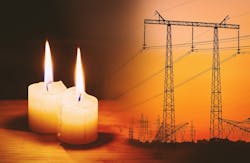Modern Challenge of Powering EVs Requires Modern Solution: Microgrids
With the grid under strain during a heat wave in late summer 2022, the California Independent System Operator alerted a San Diego school district to refrain from charging its 10 electric vehicles (EV). Lacking a microgrid to power the EV chargers, the district had to instead rent gas-powered vehicles.
“Everybody was asked to not charge, and this created a reality check about why resilience is key,” said Nick Casas, vice president of sales for EVs at Enchanted Rock, which provides microgrids.
With a microgrid in place, the school district could have continued to charge its EVs and avoid the financial and environmental costs of renting gasoline-powered cars.
Such energy emergencies aren’t expected to go away. Meanwhile, EV adoption is accelerating.
The number of direct current fast chargers, which boast a charge rate of between 50 kW and 350 kW, is expected to grow more than sixtyfold between 2022 and 2050, according to Wood Mackenzie’s latest Commercial landscape of EV charging networks in North America report. And Level 2 chargers, which have a charge rate of between 3 kW and 19 kW, are expected to grow thirtyfold in the same time frame, the report said.
Microgrid Knowledge is studying the relationship between EVs and microgrids. Will you help us by taking this survey? Your participation will further our understanding of this important market pairing and help us better inform you. Thank you! Elisa Wood, editor-in-chief
Grid ill-equipped for EVs
With this rapid deployment, the modern challenge of powering the vehicles requires the modern solution of microgrids, said Jana Gerber, North America microgrid president for Schneider Electric. The existing grid infrastructure is not equipped to manage the expected demand for electricity for charging EVs.
“Through flexible, resilient and sustainable energy support, microgrids are able to take advantage of distributed energy resources and provide power to charging stations where they are needed most,” said Gerber.
In addition, with the help of microgrids, EV batteries could be used to help stabilize the grid.
Utilities need to buy into and support microgrids for EV charging, said Casas.
In addition, it’s tough to educate people about the need when people can’t physically see microgrid technology being deployed. EV chargers, on the other hand, are often visible in store parking lots and along highways.
“We need to show the public that microgrids are not only a necessity but quicker and cleaner,” said Casas.
Quick isn't always best
Another obstacle: EV charging companies find it easier, at least at first, to connect to a utility rather than building a more complicated — and capital intensive — microgrid, said Michael Stadler, co-founder and chief technology and marketing officer at Xendee, which offers a platform for designing microgrids and distributed energy resources.
To deploy microgrids, companies need to calculate the size of the storage and make capital expenditures, he said. And funding opportunities are limited. The National EV Infrastructure Formula Program has funding available, but it’s difficult to secure because of the program’s numerous limitations, said Stadler.
But more and more, people are looking into microgrids in part because the process of connecting to utility electricity can be time-consuming and expensive, he said. Obtaining utility power for EVs often requires paying to upgrade hosting capacity and transformers.
“Microgrids can bring down the costs of charging,” said Stadler. “And if you want to be environmentally friendly, you can combine PV, storage and some new technologies around fuel cells or maybe natural gas for backup,” he added.
Xendee models business cases, including lower cost technology, battery sizes needed to sustain an outage and the savings associated with deploying a microgrid. The company can also assess how much it might cost to install charging infrastructure and upgrades to the local distribution system.
In an ideal world, EV charging companies would have access to data from utilities about issues such as hosting capacity, funding for microgrids and policy changes, Stadler said.
Demand charges
One California policy isn’t helping. The demand charge waiver for EV companies works against microgrids, said Stadler. When demand charges are high, microgrids can save money, he said.
San Diego Gas & Electric, for example, offers an interim rate waiver to medium- and heavy-duty fleet customers. The waiver helps companies lower demand charges and helps EV fleet operators save money.
But lower demand charges mean lower income potential for microgrids, which can make money in the demand charge market. They can also lower customers’ demand charges.
Examples of EV-microgrid pairings
In spite of the challenges, charging companies and businesses are beginning to use microgrids for EV charging.
Charging company Freewire has installed a microgrid in Middlegate, Nevada, an unincorporated community along US Route 50 dubbed "The Loneliest Road in America,” said Sara Dodrill, senior communications manager at Freewire.
The Freewire charger and solar microgrid were needed because the site is located in a remote area; the community is made up of a rest stop and some ranches and other private properties.
Freewire has an additional way of addressing the challenge of increased electricity demand from EV charging. The Freewire EV chargers include integrated 160-kWh batteries. This allows them to provide fast EV charging using a standard 120-volt outlet.
With the integrated battery, the Freewire system can reduce strain on the grid or the microgrid and is a solution for installing fast chargers in remote locations or locations with insufficient grid infrastructure, said Dodrill.
In addition, Enchanted Rock is working to install a microgrid at a children’s hospital in Texas that’s converting 80 fleet vehicles to EVs, said Casas.
“They want a solution that allows the community to feel safe for health care, and they will need to use EV chargers and feel sure they will be available,” he said.
With climate-induced extreme weather and its associated outages, EV chargers can’t always rely on the central grid, making microgrids a valuable asset. They can provide electric reliability along with environmental benefits.
“The islanding ability of microgrids is the perfect solution for EV charging since it will enable charging even during power outages without relying solely upon backup diesel generators, which would negate the environmental benefits of substituting EVs for gasoline-powered motor vehicles,” said Peter Asmus, director of strategic marketing at AutoGrid, which provides distributed energy resource management systems and virtual power plants. Asmus will be moderating a panel, "How to Build a Nationwide EV Network with Microgrids," on May 16 at Microgrid 2023: Lights On! in Anaheim, California.
Track news about microgrids. Subscribe to the free Microgrid Knowledge Newsletter.








